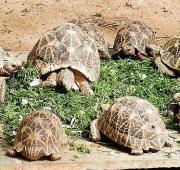 The Indian star tortoise is a medium sized species of tortoise found in the dry and arid forests of both Indian and Sri Lanka. The Indian star tortoise is named for the star-like patterns on it's high-domed shell which are distinctive to both species of star tortoise (the other being the critically endangered Burmese star tortoise, found in the deciduous forests of Burma).
The Indian star tortoise is a medium sized species of tortoise found in the dry and arid forests of both Indian and Sri Lanka. The Indian star tortoise is named for the star-like patterns on it's high-domed shell which are distinctive to both species of star tortoise (the other being the critically endangered Burmese star tortoise, found in the deciduous forests of Burma). As it's name suggests the Indian star tortoise is found across the Indian sub-continent, more specifically, the Indian star tortoise is found in the central and Southern parts of India, in West Pakistan and in Sri Lanka. The Indian star tortoise is most commonly found in semi-arid scrub forest, along with thorny and grassland habitats, where there is plenty of vegetation both to hide in and munch on.
As it's name suggests the Indian star tortoise is found across the Indian sub-continent, more specifically, the Indian star tortoise is found in the central and Southern parts of India, in West Pakistan and in Sri Lanka. The Indian star tortoise is most commonly found in semi-arid scrub forest, along with thorny and grassland habitats, where there is plenty of vegetation both to hide in and munch on.


Like many other species of tortoise around the world, the Indian star tortoise is a herbivorous animal that has a purely vegetarian diet. The Indian star tortoise browses in the dry forests of the Indian sub-continent in search of a wide variety of plant life from leaves, to fruits and berries and numerous different species of flower that are found growing in such arid environments.
Despite it's hard and protective outer shell, the Indian star tortoise is successfully preyed upon by a number of other animals in their native habitats. Large birds of prey and other reptiles such as snakes are the most common predators of the Indian star tortoise along with humans that have both hunted the tortoise for food, as well capturing them for the exotic pet trade and moving in on their native habitats.
The Indian star tortoise begins its mating season with the coming of the monsoon, so the exact time is dependent on the area in which the individual lives. Female Indian star tortoise lay an average of 7 eggs per clutch although, this can be as many as 10. The Indian star tortoise is known to be difficult to be breed in captivity and so should only be attempted by experience breeders.
Today, the Indian star tortoise has been listed as Least concern which means that allow this species is not under immediate threat from extinction, population numbers are falling across much of the Indian star tortoise's native range thanks to habitat loss and the introduction of other predators to their natural habitats.

